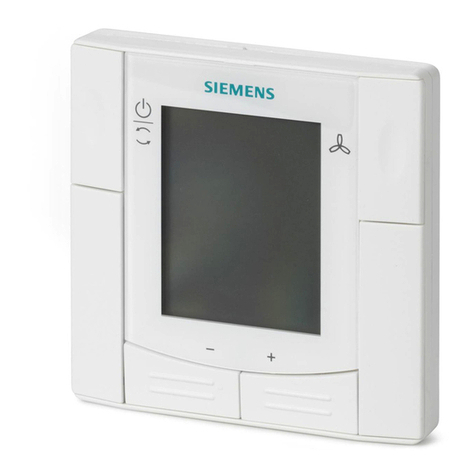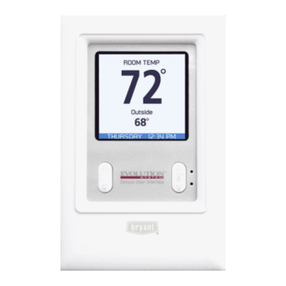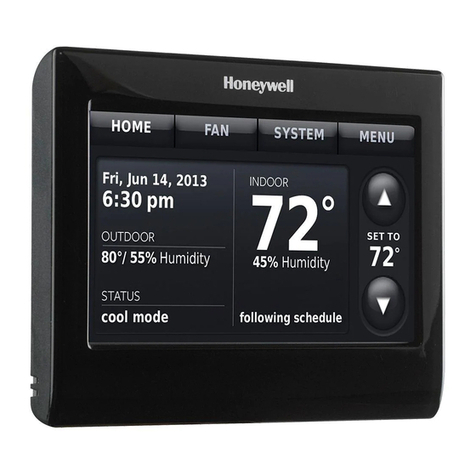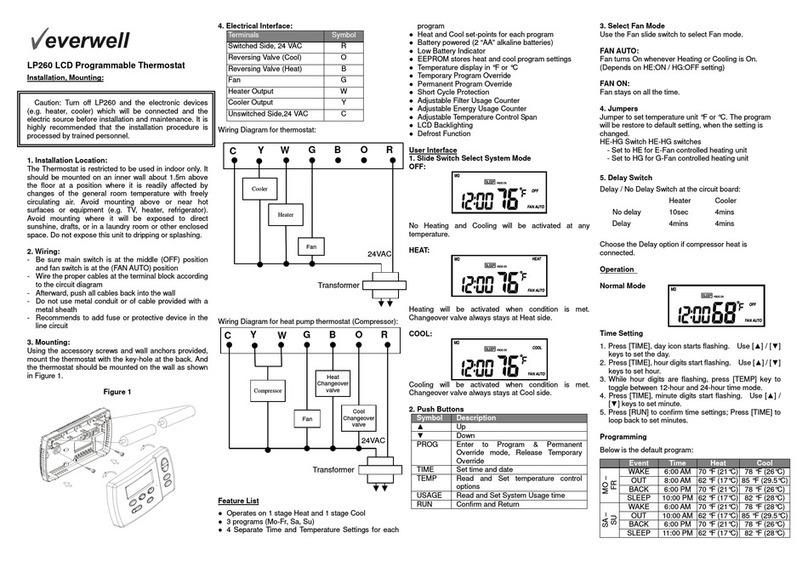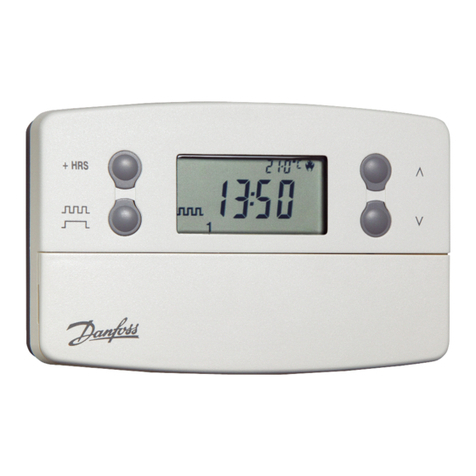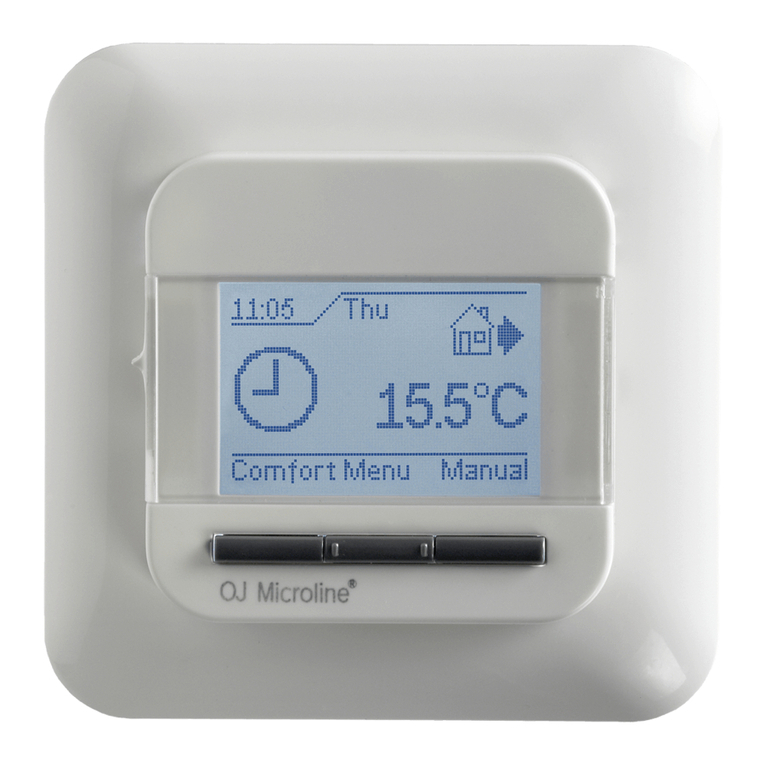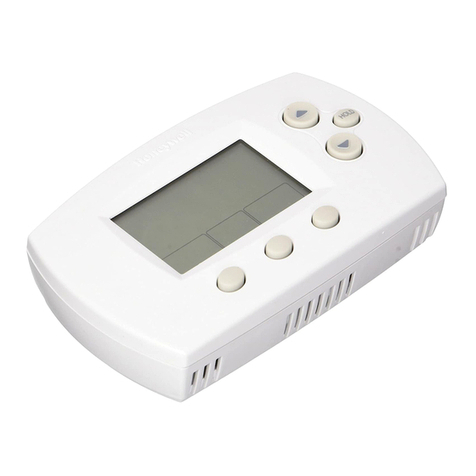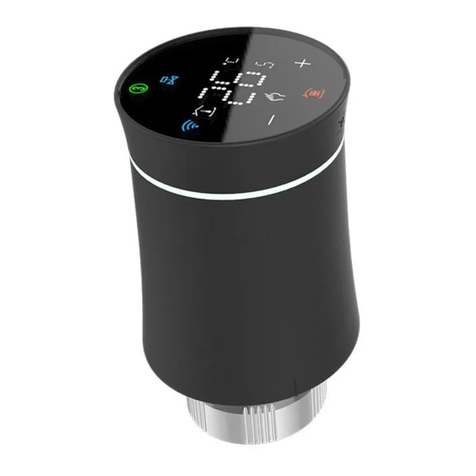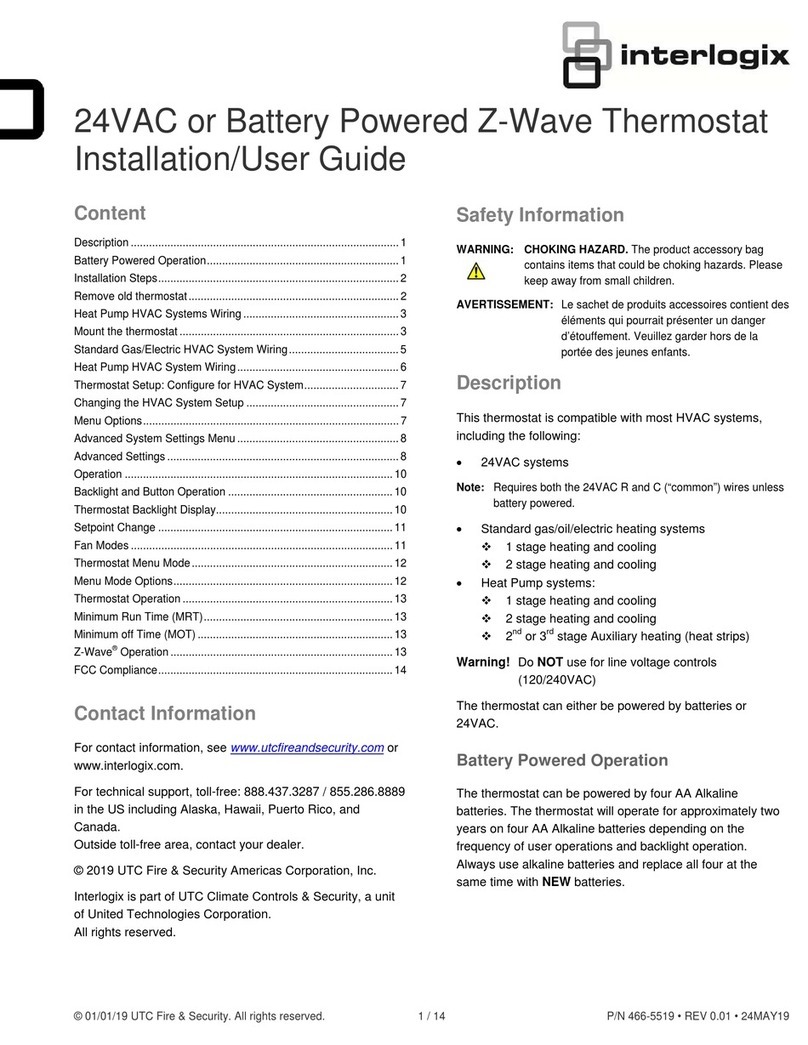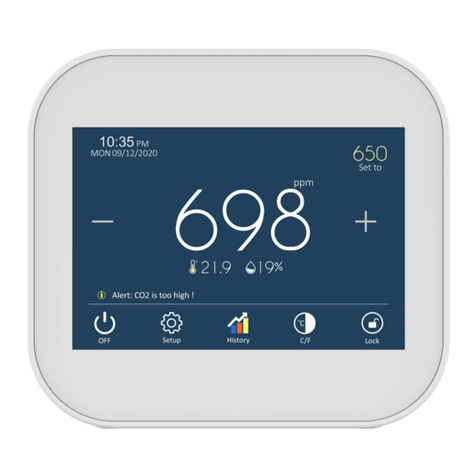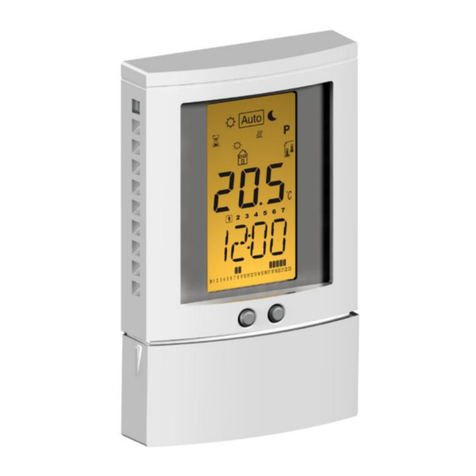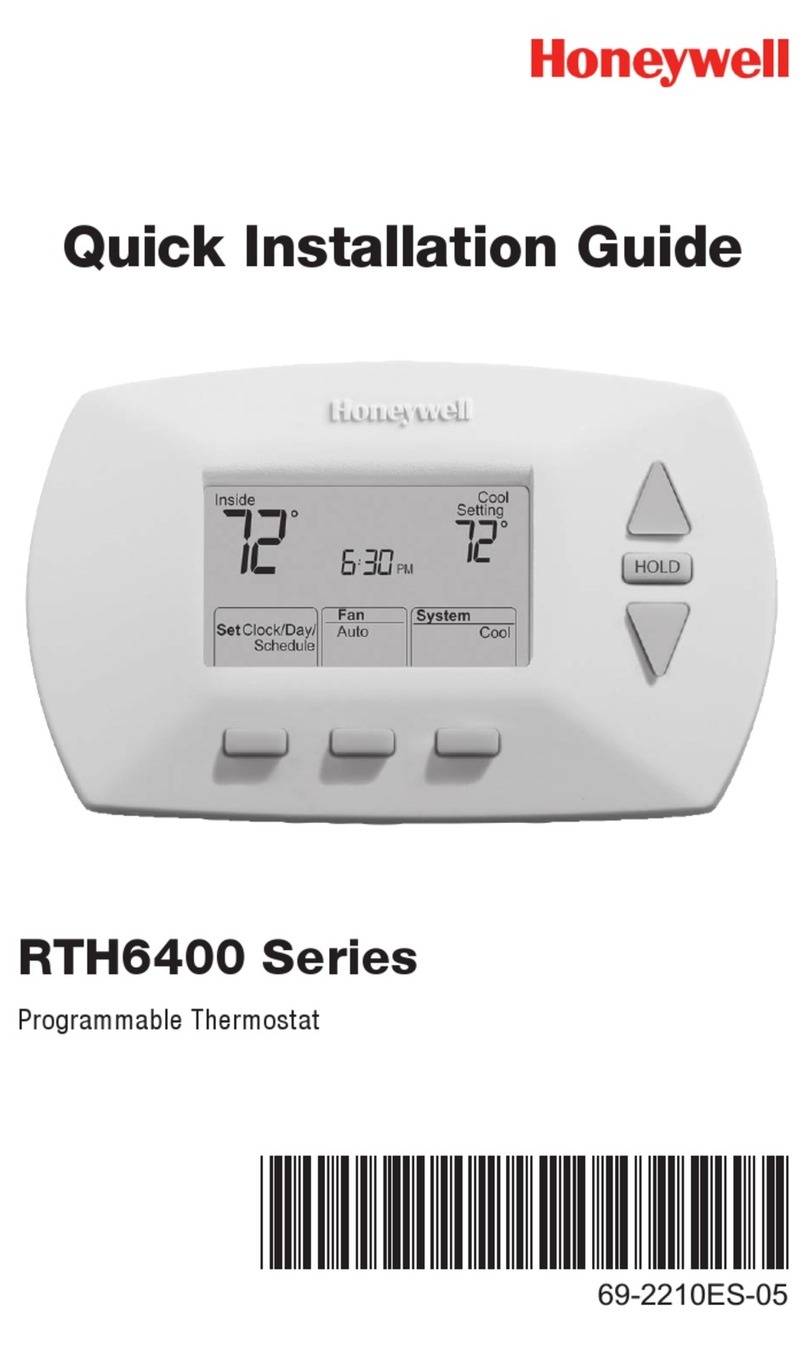Evolve T-100-R User manual

T-100-R Operation Guide

Page 2Table of Contents
Main Thermostat Screen 3
Setting the Heating or Cooling Temperature Setpoint 4
Setting the System Mode: Off, Heat, Cool, Auto 5
Setting the Fan Mode and System Status Indicators 6
Main Menu Items 7
Menu Options 8
User Settings Menu Items 9-10
Away Setpoints, Z-Wave Install & Thermostat Info 11
Thermostat Operation 12
Overview
Menu Selection
General Programming Procedure & Setback Mode Operation 13
Z-Wave Installation
Information to User 14
FCC/IC

Page 3Operation Guide
Main Thermostat Screen
MENU
COOL
MODE
72 H
AUTO
FAN HOLD
74 75 C
4:30 PM
SYS OFF
ECON
HOLD
NO MSG
Backlight Display Room Temperature Setpoints
Temperature
Setting
Warmer
Cooler
Menu
Selection
Heating/Cooling
Mode Selection
Fan Mode
Selection
Run/Hold
Mode Selection
Minimized Display
75
Press any button to return to the main thermostat screen

Page 4
Setting the Heating or Cooling Temperature Setpoint
Operation Guide
64
DONE
HEATING SETPOINT
4:30
75
MENU
HEAT
MODE HOLD
64H
82C
AUTO
FAN
Sys Off
70
Done
Press a button to
go to the setpoint
change screen
Setpoint change screen
Press the up or down arrow buttons to
set the desired temperature setpoint
Raise Temperature
Lower Temperature
Pressing the up or
down buttons will
increment the setpoint
1 degree. Press and
hold the button to ramp
the setpoint.
Press “DONE” button to set the setpoint and
exit back to the main thermostat screen or
wait for the screen to automatically time out.
If the System Mode is OFF, pressing either the Up or Down buttons will take you to the
System Mode screen. You must rst set an operating mode before you can set or change the
setpoint.
To change the Heat Setpoint you must be in the Heating mode, to change the Cool Setpoint
you must be in the Cooling mode. If you are in Auto mode, the mode of the last system call
will be the setpoint screen displayed.
Setpoint Push: Note that you cannot lower the cooling setpoint below the heating setpoint. The
thermostat will “push” the heating setpoint lower if you try to lower the cooling setpoint below the
heating setpoint. It maintains a 3 degree separation between the heating and cooling setpoint. The
same is true for raising the heating setpoint above the cooling setpoint. Again the thermostat will
“push” the cooling setpoint up to maintain the 3 degree separation.

Page 5
Setting the System Mode: Off, Heat, Cool, Auto
Press Mode button to
change system mode
System Modes
• OFF: System is off. No heating or cooling will come on. If system was on, it will turn off
immediately.
• HEATING: Only heating will occur.
• COOLING: Only cooling will occur.
• AUTO: Heating or cooling will come on according to the heating and cooling setpoints. The
system will automatically switch between heating and cooling modes as needed to maintain the
setpoints.
Special Heat Pump Mode: Emergency Heat
• EHEAT: An additional system mode, “EHEAT” for Emergency Heat will be displayed if the HVAC
system type is set to Heat Pump. If there is a compressor failure with the Heat Pump system,
setting the mode to EHEAT will allow the supplemental Aux heat to come on rst whenever there
is a call for heating. It also disables the compressor output to prevent further damage to the
HVAC system.
Operation Guide
Done
MODE
SYSTEM MODE
OFF
HEATING
COOLING
AUTO
4:30 PM
75
MENU
HEAT
MODE HOLD
64H
82C
AUTO
FAN
Sys Off
System Mode change screen
Press the
UP or
DOWN buttons
or
MODE button
to select the
desired system
mode
Press “DONE” button to select the mode and exit back
to the main thermostat screen or wait to automatically
time out.

Page 6
Setting Fan Mode and System Status Indicators
Operational Fan Mode
Fan Cycler. If the Fan Cycler feature is enabled in the Installer Setup, the additional fan mode
“Cycle” will be shown in the Fan Mode menu. This mode cycles the fan on and off continuously for
fresh air ventilation according to the settings in the Installer Setup.
System Operation Mode Indicator
“SYS OFF” displayed System is OFF.
“SYS MOT” displayed System is OFF and Minimum Off Time (MOT) delay On is active.
“HEAT ON” displayed System is ON and heating.
“COOL ON” displayed System is ON and cooling.
“HEART MRT” displayed System is ON and heating. Min. Run Time (MRT) delay off is active.
“COOL MRT” displayed System is ON and cooling. Min. Run Time (MRT) delay off is active.
Operation Guide
75
MENU
HEAT
MODE HOLD
64H
82C
AUTO
FAN
Sys Off
2nd Stg
Filter
4:30 PM
System
Status
Indicators
Press the Fan button to change the Fan mode.
• AUTO FAN: Fan automatically operated by the HVAC
system.
• FAN ON: Manual Fan mode. Fan stays on until mode
is changed back to Auto.
Staging Display
"2nd Stg" displayed Stage 2 heating or cooling is ON
"Aux Heat" displayed Stage 3 heating is ON
Home/Away Display
Home mode is active (current setpoints are being used)
Away setback mode is active (setback points are being used)
System Alerts
Alert Text displayed Specic alert text (Filter or Maintenance Timer)
For Heat Pump systems only: "EHEAT"
emergency heat mode active

Page 7Operation Guide
Menu Selection
4:30 PM
Menu Selection
Se
l
ect
Energy Usage
Utility Setup
Messages
Schedules
Done
75
MENU
HEAT
MODE HOLD
64H
82C
AUTO
FAN
Sys Off
Press Menu button to go
to the main menu screen
Use the
UP/DOWN
buttons to select
the desired menu
item
Press DONE to go back to
the main thermostat screen
Press SELECT to go to the
menu item screen
Main Menu Items
• Energy Usage Enabled for In-Home Display versions
• Utility Setup Enabled for In-Home Display versions
• Messages Enabled for In-Home Display versions
• Schedules Optional, used to view and set programmable schedules
• User Settings Set various user preferences
• Away Setpoints Show and set the heating and cooling setback setpoints
• Z-Wave Install Z-Wave installation
• Thermostat Info Displays thermostat setup info
Schedules is an optional menu item. It will only show up in the menu list if “Schedules” is enabled in
the Installer settings for the thermostat. Provides for local schedule control. The Schedules Screen
allows you to review and set the setback schedule for the thermostat. The thermostat has a 4 x 7
schedule. Four times a day can be selected for changes to the heating and cooling setpoints. Each
day of the week can have a different schedule. Groups of days can be copied with the same
schedule. When the thermostat is set to “Run” mode, the schedule will be executed daily, with the
setpoints being changed...

Page 8Operation Guide
...as per that days schedule stored in the thermostat. “Hold” mode stops schedule operation and
holds the current setpoints until changed manually or by network commands.
The Schedules Screen gives you the option of setting a custom setback schedule or to load one of
two preset schedules.
Menu Options
• Heat and Cool: You can change the individual day/hour and setpoints
for the Heating and Cooling schedule by selecting this menu item.
• Preset: Comfort: This is a preset schedule with mild setbacks. Select
the menu item to load the Comfort schedule into the thermostat.
Conrmation screen will be displayed for Yes/No entry.
• Preset: EnergyMiser: This is a preset schedule with deeper setbacks.
Select this menu item to load the EnergyMiser schedule into the
thermostat. Conrmation screen will be displayed for Yes/No entry.
Select Schedule
Select
Done
Schedule Screen
When you select the Heat and Cool Schedule menu item, the “day”
schedule programming screen opens and the schedule for current day will
be displayed. Use the scroll buttons to highlight the data to be modied.
Once the data has been highlighted, use the +/- buttons to change the
value of the data. To copy a days schedule to another day or group of
days, move the cursor to “C” on the bottom right of the schedule screen.
When you highlight the “c”, the button below will become “Copy”. Press
this button to change to the Copy Schedule Screen.
DONE NEXT
Monday Schedule
Time Heat Cool
Wake 06:00 A 70 79
Day 08:00 A 62 85
Eve 04:00 P 70 78
Sleep 10:00 P 62 82 C
+
-
Copy Schedule Screen
The Copy Schedule screen is a sub screen of the Schedule screen. The
Copy Schedule screen allows you to copy a day’s schedule to another day
or group of days.
First select the day to be copied in the Schedule screen. Scroll to the “c”
at the bottom of the Schedule screen to highlight it. The “Next” button will
change to the “Copy” button. Press the “Copy” button to open the Copy
Schedule screen.
Scroll through the days and select the days you want to copy the schedule
to by setting the “N” under each day to “Y” by using the Yes/No buttons.
After selecting all the days desired, press the “COPY” button.
Exit the Copy Schedule screen with the “DONE” button.
DONE NEXT
Monday Schedule
Time Heat Cool
Wake 06:00 A 70 79
Day 08:00 A 62 85
Eve 04:00 P 70 78
Sleep 10:00 P 62 82 C
+
-

Page 9Operation Guide
User Settings Menu Items
• Set Clock go to the clock setting screen
• Filter Service go to the lter timer setup screen
• Maint Service go to the maintenance timer setup screen
• Screen Timeout sets the time in seconds to switch to the minimized
screen
• F/C Settings go to the F/C mode selection screen
• Sensor Calibration go to the sensor calibration screen
• Backlight/Display go to the backlight and display setup screen
Select Schedule
Select
Done
Set Clock
The Set Clock screen allows you to set the Thermostat’s internal clock.
To set the Time and Date, move the cursor with the navigation arrows until
the data you want to change is highlighted.
Using the + and - buttons to increment or decrement the data to the
desired setting.
When finished, press the SET button to return to the Main Menu screen or
wait for screen to timeout.
Select Schedule
Select
Done
If the clock has been reset by an extended power outage, the Clock display on the thermostat
screen will be blinking. Pressing the MENU button will take you directly to this screen to
set the clock.
Filter Service
Go to the Filter Service Screen. Sets/resets the filter timer/alert.
Shows filter runtime in hours and the service interval alert in hours (typically 300 hrs)
Change the service interval with the +/- buttons.
Reset the service alert after you have changed the filter.
Maint Service
Go to the Maintenance Service Screen. Sets/resets the maintenance timer/alert.
The Maintenance Service screen will show the accumulated Heat and Cool runtime hours as well as
the Service Interval that will be used to trigger a Maintenance alert.
Service interval is 3000 hours. Use the +/- buttons to adjust service interval. Press reset to clear the
service alert and reset the runtimes to zero.
When the combined HEAT and COOL Runtime hours equals the Service Interval hours, a “Maint”
message will be displayed as a reminder that the HVAC system may require periodic maintenance.
Pressing the Menu button will take you to the Filter Service screen. The Reset button can be pressed
and the HEAT and COOL Runtime values will be reset to zero.

Page 10
Screen Timeout
Minimized Screen. Set the display timeout time in seconds. Options are 0 or 15 to 120 (default set to
0 seconds). This is the time before the main thermostat screen reverts to the minimized temperature
only display screen, after the last button press. The Minimized Screen feature is disabled by setting
this time to “0”.
Any button press will restore the main thermostat screen display.
F/C Settings
Go to the F/C Settings Screen. Select which temperature display mode you desire, Fahrenheit (F) or
Celsius (C).
Sensor Calibration
Go to the Sensor Calibration Screen. This screen allows you to adjust the calibration of the internal
sensor. You can change the temperature calibration by +/- 7 degrees using the + and – buttons.
When the Sensor Calibration screen is selected it will show the current temperature calibration and
the current number of degrees of offset being applied (typically 0). If the sensor’s actual temp is (74)
with 0 degrees of offset and you want it to show 75, then press “+” to add 1 deg and it will show
(75).
You can refresh the info on this screen by pressing the right hand (blank) button.
When you close this screen, it may take a few seconds for the temperature displayed on the main
thermostat screen to update to the new temperature selected.
Backlight/Display
Go to the Backlight/Display settings screen. This menu allows you to set the backlight timeout
period and adjust the display contrast.
Backlight Timeout: Sets the time from last button press that the backlite will timeout and turn off.
The timeout value is adjustable from 0 or 20 to 120 seconds. If set to “0”, the Backlite will always be
ON. If set in the range of 20 to 120 seconds, the Backlite will turn OFF after the selected time
expires.
ON Level: Sets the backlight brightness when it is on. Adjustable from 0 to 100% in 5% steps.
Screen will change brightness as you adjust setting.
OFF Level: Sets the backlight brightness when it is off. Adjustable from 0 to 100% in 5% steps. Can
be 0% = off or a low level for night viewing.
Contrast: Sets the contrast level of the LCD display, adjustable from 0 to 20. Use this control to
adjust the sharpness of the display. To light and the display looks faded, too dark and dark lines will
appear in the display. Typically 10-15 is a good setting. Adjust as needed.
Operation Guide

Page 11Operation Guide
Away Setpoints
Away setpoints are used when the thermostat is set to the setback or away mode.
Z-Wave Install
This menu item allows you to install or uninstall the thermostat into the Z-Wave network. Follow the
instructions in the Z-Wave Installation section.
Thermostat Info
The Thermostat Info screen displays the current configuration of the thermostat. This information
is useful for quick check of firmware versions and HVAC system setup. It also shows the Z-Wave
network settings.
Thermostat information displayed is:
• Thermostat - Model and firmware version number
• Z-Wave Settings - Z-Wave Firmware version, Z-Wave Node ID, Z-Wave Home ID
• System Type - Standard or Heat Pump HVAC system
• Fan Type - if HVAC type = Standard: Gas or Elect, OR
• Changeover - if HVAC type = Heat Pump: Changeover with cool or changeover with heat
Thermostat Info Screen
Setup Button: To setup the thermostat to work with your HVAC system, press and hold the "Setup"
button. This will take you to the installation setup screen. See installation instructions for proper
settings.
Status Button: Press and hold this button. A system status screen will show the output status of
thethermostat relays.
Done Button: Press "Done" to exit the Thermostat Info screen back to the main menu.
Done Set
Away Setpoints
-
+
Away –Heat 65
Away –Cool 80 Use up/down buttons to select
setpoint to change
Use +/- buttons to increase or
decrease the temperature
Press DONE to store
the setting and exit back to the
main menu
Done Setup
TZ45R Ver 01.00.00
ZVER: 2.97 ZNID: 001
ZHID: 00.00.07.76
System Type: Standard
Fan Type: Gas
Thermostat Info
Status
Press and Hold Setup button
to go to the HVAC system
setup screen

Page 12Operation Guide
Thermostat Operation
Minimum Run Time (MRT)
The thermostat has a Minimum Run Time
after the start of any heating or cooling call.
This minimum run time assures even heating
and cooling cycles. The MRT delay will keep
the system on even if reaches setpoint or you
change the setpoint to a temperature that
would satisfy the call, until the MRT expires.
Changing the Mode to OFF will cancel the
MRT and the system will turn off immediately.
The MRT can be adjusted in the Installer
Settings menu of the thermostat.
Note: The MRT status is shown in the
thermostat System Status on-screen labels.
Minimum Off Time (MOT)
The thermostat has a Minimum Off Time after
any heating or cooling call is finished. This
delay prevents rapid heating/cooling cycles
and also provides “short cycle protection” for
compressor calls. This delay may be
noticeable when you change a setpoint and it
does not respond immediately due to another
call that has recently completed and the MOT
delay timer is preventing the system from
restarting. The MOT delay time can be
adjusted in the Installer Settings menu of the
thermostat. There is a minimum of 5 minutes
delay to assure compressor protection.
Note: The MOT status is shown in the
thermostat System Status on-screen labels.

Page 13Operation Guide
Z-Wave Installation
Z-Wave controllers from various manufacturers may support the Z-Wave Thermostat General V2
Device class used by the Z-WAVE Thermostat. The following procedure will allow the thermostat to
be added to a Z-Wave network.
General Programming Procedure (for controllers supporting the thermostat device class):
1. Set your primary controller to Include, Add or Install mode, to add the thermostat as a node
on your network (see your controller’s user manual for detailed instructions).
2. In the Thermostat's Main Menu, scroll down to the Z-Wave Install item. Select the item.
3. When prompted by your Z-Wave controller, Press the YES button in the Z-Wave Install
screen.
Your controller will indicate the thermostat was successfully added to its network (see your
controller’s user manual for details). Also you can check if the thermostat was successfully added
to the network by checking the ZHID (Home ID) and ZNID (Node ID) located in the Thermostat Info
screen.
For other specic tasks such as adding the thermostat to Scenes or Groups, or deleting the
thermostat from an existing network, use the Z-Wave Install procedure.
Note: Before adding the thermostat to a Z-Wave Network, check that it does not already belong to one by viewing the
Node ID (ZNID) located in the Thermostat Info screen. An un-installed thermostat should show zeros for the Node ID
(000). Consult your controller’s user manual for details on removing a device from a Z-Wave network.
Setback Mode Operation
If your controller does not support full thermostat device class functions, it may still be able to
control the energy saving AWAY mode of the thermostat through BASIC_SET commands.
Sending the BASIC_SET (Value = 0x00), the thermostat will go into the AWAY mode and use the
predened AWAY setback setpoints. These setpoints are set in the Main Menu Away Setpoints item.
Sending the BASIC_SET (Value = 0xFF), the thermostat will revert back to the Home mode it was in
before the BASIC_SET (Value = 0x00) command was sent.
Note that when the BASIC_SET commands are sent, the T-100R will momentarily display the new
mode.
Setback Mode Operation
Inclusion or exclusion is started by putting the controller into add node or remove node state and
performing the General Programming Procedure outlined above. As part of the process, the
thermostat sends a node information frame at normal power.
Low power inclusion or low power exclusion is not possible.

Page 14Operation Guide
FCC/IC
INFORMATION TO USER
This device complies with Part 15 of the FCC Rules. Operation is subject to the following two
conditions: (1) This device may not cause harmful interference, and (2) This device must accept any
interference received, including interference that may cause undesired operation.
This equipment has been tested and found to comply with the limits for Class B Digital Device,
pursuant to Part 15 of the FCC Rules. These limits are designed to provide reasonable protection
against harmful
interference in a residential installation. This equipment generates and can radiate radio frequency
energy and, if not installed and used in accordance with the instructions, may cause harmful
interference to radio communications. However, there is no guarantee that interference will not occur
in a particular installation. If this equipment does cause harmful interference to radio or television
reception, which can be determined by turning the equipment off and on, the user is encouraged to
try to correct the interference by one or more of the following measures.
• Reorient or relocate the receiving antenna
• Increase the separation between the equipment and receiver
• Connect the equipment into an outlet on a circuit different from that to which the receiver is
connected
• Consult the dealer or an experienced radio/TV technician for help
Any changes or modications not expressly approved by the party responsible for compliance could
void the user’s authority to operate the equipment.
This device complies with Industry Canada license-exempt RSS standard(s). Operation is subject
to the following two conditions: (1) this device may not cause interference, and (2) this device must
accept any interference, including interference that may cause undesired operation of the device.
Le présent appareil est conforme aux CNR d'Industrie Canada applicables aux appareils radio
exempts de licence. L'exploitation est autorisée aux deux conditions suivantes : (1) l'appareil ne doit
pas produire de brouillage, et (2) l'utilisateur de l'appareil doit accepter tout brouillage radioélectrique
subi, même si le brouillage est susceptible d'en compromettre le fonctionnement.

www.evolvecontrols.com
Other manuals for T-100-R
1
Table of contents
Other Evolve Thermostat manuals


